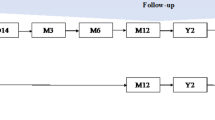Abstract
This study was intended to determine the 5-year mortality of 2138 post–myocardial infarction (MI) patients who took part in the Secondary Prevention Reinfarction Israeli Nifedipine Trial (SPRINT). In the framework of the SPRINT study, 1065 patients were randomly assigned 30 mg/d nifedipine therapy, for a mean 10-month follow-up period, and 1073 received placebo. No information is available concerning treatment after the first year. One-year postdischarge mortality was 5.0% in the placebo group and 5.9% among patients receiving nifedipine P = 0.37). Mortality rates after 5 years of follow-up in patients previously randomized to 1 year of nifedipine therapy and placebo were 18.4% and 18.3%, respectively. The 5-year mortality risk ratio associated with randomization to nifedipine over 1 year, adjusted for age, gender, past MI, angina, diabetes, hypertension, MI location, and therapy, was 1.00 (95% CI: 0.81–1.22). Our results do not support an association between nifedipine therapy and a late harmful effect on long-term mortality.
Similar content being viewed by others
References
Braunwald E, Muller JE, Stone PH. Use of calcium channel blocking agents in the management of ischemic heart disease. Eur Heart J 1985;6(Suppl A):31-36.
Rick KR, Gervino E, Jarise WR, Stone PH. Effects of nifedipine on myocardial perfusion during exercise in chronic stable angina. Am J Cardiol 1990;65:1097-1101.
Frishman WH, Rosenberg A, Katz B. Calcium antagonist in the management of systemic hypertension: The impact of sustained-release drug delivery systems. Cor Art Dis 1994; 5:4-13.
Taylor SH. Usefulness of amlodipine for angina pectoris. Am J Cardiol 1994;73:28A-33A.
Cone PF, Vetrovec GW, Nesto R, et al. The Nifedipine-Total Ischemia Awareness Program: A national survey of painful and painless myocardial ischemia including results of anti-ischemic therapy. AmJCardiol 1984;63:534-539.
Yusuf S, Held PH, Furberg CD. Update of effects of calcium antagonists in myocardial infarction or angina in light of the second Danish Verapamil InfarctionTrial (DAVIT II) and other recent studies. Am J Cardiol 1991;67:1295-1297.
Lichtlen PR, Hugenholtz PG, Raffenbuell W, Hecker H, Jost S, Deckers JW on behalf of the INTACT group. Retardation of angiographic progression of coronary artery disease by nifedipine: Results of the International Nifedipine Trial on Antiatherosclerotic Therapy (INTACT) Lancet 1990;335: 1109-1113.
Psaty BM, Heckhert SR, Koepsell TD, et al. The risk of myocardial infarction associated with anti-hypertensive drug therapies. JAMA1995;274:620-625.
Furberg CD, Psaty BM, Meyer JV. Nifedipine: Dose related increase in mortality in patients with coronary heart disease. Circulation 1995;92:1326-1331.
Pahor M, Guralnik JM, Corti MC, Foley DJ, Havlik RJ. Long-term survival and use of antihypertensive medications in older persons. J Am Geriatr Soc 1995;43:1191-1197.
The Israeli SPRINT Study Group. The Secondary Prevention Reinfarction Israeli Nifedipine Trial (SPRINT). A randomized intervention trial of nifedipine in patients with acute myocardial infarction. Eur Heart J 1988;9:354-364.
Cox DR. Regression models and life tables. J R Stat Soc 1972;B34:187-220.
Koenig W, Lowel H, Lewis M, Hormann A. Long-term survival after myocardial infarction: Relationship with thrombolysis and discharge medication. Eur Heart J 1996;17: 1199-1206.
Messerli FH. Case-control study, meta-analysis, and bouillabaisse: Putting calcium antagonist scare into context. Ann Intern Med 1995;123:888-889.
Calcium antagonist caution [Editorial] Lancet 1991;337: 885-886.
Lenfant C. The calcium channel blocker scare: Lessons for the future. Circulation 1995;91:2855-2856.
Kaplan NM. Do calcium antagonists cause myocardial infarction? Am J Cardiol 1996;77:81-82.
Kloner RA. Nifedipine in ischemic heart disease. Circulation 1995;92:1074-1078.
Yusuf S. Calcium antagonists in coronary artery disease and hypertension: Time for re-evaluation. Circulation 1995;92: 1079-1082.
Opie LH, Messerli FH. Nifedipine and mortality: Grave defects in the dossier. Circulation 1995;92:1068-1073.
Jackson G. Calcium antagonists:When the content does not justify the headline. Br JClin Pharmacol 1995;19:283-284.
TheDanish Study Group on Verapamil in Myocardial Infarction. Effect of verapamil on mortality and major events after acute myocardial infarction: The Danish Verapamil Infarction Trial II (DAVIT-II). AmJ Cardiol 1990;66:779-785.
Multicenter Diltiazem Post Infarction Trial Research Group. The effect of diltiazem on mortality and reinfarction after myocardial infarction. N Engl J Med 1988;319:385-392.
Held PH, Yusuf S, Furberg CD. Calcium channel blocking agents in acute myocardial infarction and unstable angina: An overview. Br Med J 1989;299:1187-1192.
Goldbourt U, Behar S, Reicher-Reiss H, Zion M, Mandelzweig L, Kaplinsky E, for the SPRINT Study Group. Early administration of nifedipine in suspected acute myocardial infarction. Arch Intern Med 1993;153:345-353.
Holland Interuniversity Nifedipine/Metoprolol Trial (HINT) Research Group. Early treatment of unstable angina in the coronary care unit: A randomized, double-blind, placebo controlled comparison of recurrent ischaemia in patients treated with nifedipine or metoprolol or both. Br Heart J 1986;56:400-413.
Muller JE, Morrison J, Stone PH, et al. Nifedipine therapy for patients with threatened and acute myocardial infarction: A randomized, double-blind, placebo-controlled comparison. Circulation 1984;69:740-747.
Elkayam U, Amin J, Mehra A, Vasquez J, Weber L, Rahimtoola SH. A prospective, randomized, double-blind, crossover study to compare the efficacy and safety of chronic nifedipine therapy with that of isosorbide dinitrate and their combination in the treatment of chronic congestive heart failure. Circulation 1990;82:1954-1961.
Packer M, O'Connor CM, Ghali JK, et al. for the Prospective Randomized Amlodipine Survival Evaluation Study Group. Effect of amlodipine on morbidity and mortality in severe chronic heart failure. N Engl J Med 1996;335:1107-1114.
Parmley WW. A delayed answer to the calcium blocker question. J Am Coll Cardiol 1996;27:510-511.
Author information
Authors and Affiliations
Rights and permissions
About this article
Cite this article
Reicher-Reiss, H., Behar, S., Boyko, V. et al. Long-Term Mortality Follow-up of Hospital Survivors of a Myocardial Infarction Randomized to Nifedipine in the SPRINT Study. Cardiovasc Drugs Ther 12, 171–176 (1998). https://doi.org/10.1023/A:1007779026915
Issue Date:
DOI: https://doi.org/10.1023/A:1007779026915




